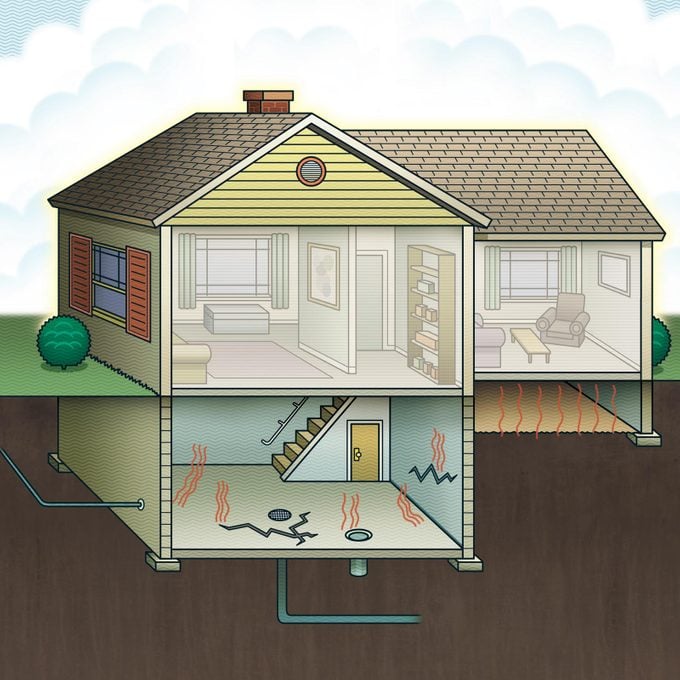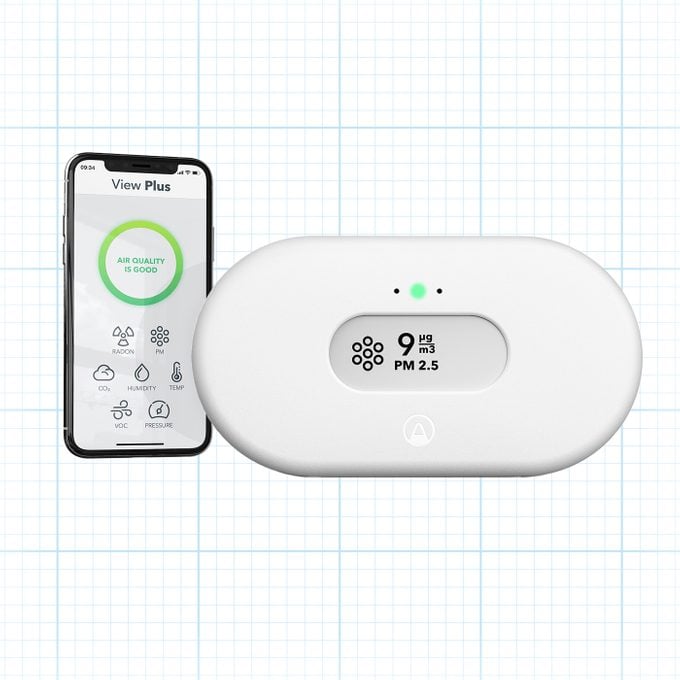How to Test for Radon in Your Home
Updated: Apr. 25, 2024

Radon can show up in any home, and elevated levels can cause lung cancer. Here's how to test for, monitor and mitigate radon in your home.
Our neighbors tested their house for radon and discovered they didn’t have elevated levels, so we just assumed our house was safe as well. We procrastinated testing — for about a decade — and when we finally did radon testing, we were shocked to discover that we were living with unsafe levels.
Today we’re optimistic that we’re okay because we tend to keep our windows open and the house circulates fresh air well, though only time will tell. Radon’s health dangers come from its cumulative effect over years. We’ve since installed a radon mitigation system and now encourage others to actively monitor their homes as well.
Monitoring and testing for radon should be an ongoing part of your home health safety routine, even if you’ve tested negative in the past. Here’s why, plus how to test for radon and what to do if you find it.
On This Page
What Is Radon?
Radon is a naturally occurring radioactive gas that you can’t see, smell or taste. It’s also a known carcinogen.
Where Does Radon Come From?

Radon comes from the ground. Rocks, soil and water contain small amounts of uranium. Those break down over time through a process called radioactive decay, forming radon gas. Radioactive particles in radon gas can seep into our homes directly through concrete pores and, more significantly, through gaps and cracks in walls and floors. In rare instances, it can also be infused in water, and thus enter buildings through showers and faucets.
What Are the Risks of Radon?
Long-term exposure to high concentrations of radon is the leading cause of lung cancer among non-smokers, killing an estimated 21,000 people a year, according to the EPA. If you smoke, radon exposure “greatly enhances the risk of lung cancer,” according to the American Lung Association. But the risks are cumulative, which means living with it for a short amount of time until the problem is fixed probably won’t negatively impact your health.
Where Is Radon Found?
Radon is found all over the country, with an estimated one in 15 homes having elevated levels. “Even though it is naturally occurring, the radon gas concentration inside is often much higher than outdoors,” says Jørgen Solstad, director of consumer products at Airthings. “Radon can build up in the air in any home or building whether it has a basement, is sealed or drafty, is new or old.”
Radon Levels, Explained
The amount of radon in the air is measured in picocuries per liter (pCi/L). International standards dictate:
- Minimal levels (up to 1.3 pCi/L) are considered safe, but should still be monitored.
- Low levels (1.3 to 2.6 pCi/L) are classified as acceptable. “While immediate intervention is not imperative, homeowners can experiment with ventilation and sealing foundation cracks as a preventive measure,” says Solstad.
- Moderately high levels (2.7 to 4 pCi/L) warrant enhanced ventilation and monitoring. “If no improvement is observed after three months, consult a professional radon mitigator,” says Solstad.
- High-risk levels (above 4 pCi/L) for more than one month require prompt, professional mitigation.
What Are the EPA’s Action Levels for Radon?
4 pCi/L. “But a radon level below 4 pCi/L still poses a health risk,” says Nancy Bredhoff, President of Radon Testing Corporation of America. “You should consider fixing when the radon level is between 2 and 4 pCi/L.”
How To Test for Radon
There are three common methods for radon testing your air:
- Short-term test kits, which you leave out for two to 90 days, then send to a lab.
- Long-term test kits, which measure year-round average levels.
- Digital monitors can provide both sets of figures in real time and don’t require lab analysis.
If you go the test kit route, you can DIY it or hire a certified radon professional. If you DIY it, conduct the test in the lowest livable area of your house that is regularly used eight to 10 hours per week.
How To Get Rid of Radon
For lower levels of radon, the simplest solution is to increase ventilation and natural air flow by opening doors and windows, and sealing cracks in the foundation or basement floor. If that doesn’t work, or isn’t possible due to weather or your home’s layout, then you’ll need more formal mitigation.
“The most common system is a vent pipe and fan, where the radon from beneath the house is vented to the outside,” says Bredhoff. In some cases these are DIY-able, but pros can alleviate safety concerns like preventing combustion appliance backdrafting. The National Radon Safety Board offers this resource for finding a radon professional in your area, or you can contact your state radon program.
How To Make Your House Safe from Radon
Because radon levels fluctuate, ongoing monitoring with a digital detector can help you determine if and when you have a radon problem. Also, keep your home well-ventilated and seal radon access points. “Sealing large cracks and openings in any home is good for energy consumption and can also help with radon,” says Solstad.
What Are Radon Detectors and How Do They Work?

Radon detectors monitor the amount of radon particles in a room. You can move them from room to room to test multiple areas and see if your radon mitigation solutions are working.
Some digital radon detectors, like the Airthings’ View Plus, can also monitor other potential air quality issues, like CO2, PM2.5, VOCs, temperature, pressure and humidity.
FAQs
What States Have Higher Levels of Radon?
Elevated levels of radon occur in every state, but especially in areas with high levels of uranium in the underlying rock and soil. You can check Airthings’ live radon readings here, but remember that radon levels can vary from neighborhood to neighborhood and even house to house.
What Season Is Radon Highest?
Temperature, pressure, humidity, rain and snow are all seasonal environmental factors that impact the amount of radon emitted from the ground, says Solstad. Therefore, “The months between October and February are considered radon season, when levels are often highest and winter behavior like keeping windows and doors closed also elevates levels.”
What Are Safe Levels of Radon?
“The EPA believes that any radon exposure carries some risk; no level of radon is safe,” says Bredhoff. However, radon levels measured below 1.3 pCi/L are low enough to be considered acceptable and do not require immediate action to be taken.
Is It Okay to Live in a House with Radon?
Yes, it is okay to live in a house with elevated radon for a short amount of time, or as long as levels are below 1.3pCi/L, since radon’s negative health affects accumulate over time. “It is nearly impossible to avoid radon completely, hence many people live in their homes with some exposure to radon, but it is advised to minimize radon exposure as much as possible,” says Solstad.
About The Experts
Nancy Bredhoff is President of Radon Testing Corporation of America, Inc. (RTCA) and volunteers on the board of the National Radon Safety Board (NRSB). She has been involved in the radon industry since 1986.
Jørgen Solstad is director of consumer products for Airthings, where he oversees the product development and deployment of the line of products designed for home use. Airthings has sold more than one million monitors worldwide, which help people monitor radon and other air quality concerns in their homes. The company has received a TIME Best Inventions Award and a CES Innovation Award Honors.
Sources
- American Lung Association radon FAQ
- EPA consumer guide to radon reduction
- National Radon Action Plan
